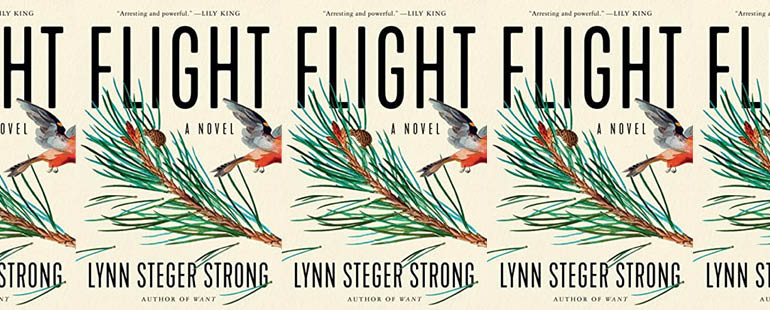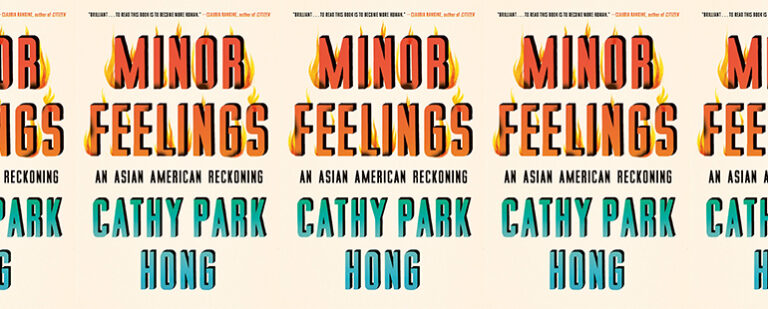An Exploration of the Collective in Flight

In Lynn Steger Strong’s novel Flight, out this week, three grieving siblings come together with their spouses and children for a family holiday gathering eight months after their mother, Helen, suddenly passed away. Instead of traveling south to their childhood home in Florida, as they have done every year since leaving home—following the flight patterns of migratory birds en route to coastal wintering grounds—they drive into the cold, snowbound landscape of upstate New York, where middle child Henry now lives with his wife, Alice, a social worker who is preoccupied with helping one of her clients who recently returned to the custody of her mother. A deeply affecting family novel told in multi-character, third-person limited points of view, Flight demonstrates how people move as both individuals and as part of a collective—much like the birds that flock overhead—as they endeavor to love each other in a time of crisis.
The novel is structured in three sections. The opening section, titled “December 22: The Cars,” consists of just four chapters, which serve to introduce the novel’s four families. There’s Martin, the eldest sibling and a college professor who has been placed on leave due to allegations of misconduct, who is married to Tess, a high-powered lawyer; along with their two children, they pack up the car to set out from their home in New York City. Then, there’s the youngest sibling, Kate, a stay-at-home parent who is traveling from Virginia in her minivan, which smells of “pee and old bananas,” with her three young children and husband, Josh, who has recently lost his inherited wealth to bad investments and is also underemployed. More than anything, Kate wants to convince her siblings that she should raise her family in their now empty childhood home; the house’s fate is an open question since Helen did not leave a will. Then there’s Henry and Alice, who is in her car running errands as she readies to host her in-laws. Alice used to be an artist, like Henry, but since becoming a social worker has formed a strong bond with Quinn, a precocious six-year-old whose mother, Maddie, is recovering from a substance use disorder. In the fourth and final introductory chapter, the focus shifts to Maddie, who is walking Quinn home when she sees Alice’s car parked near their apartment, from which she is observing them. Alice visits more frequently than her job warrants, perhaps because she is still coming to terms with her body’s inability to carry a pregnancy to term and her longing for a child.
The novel’s next section is titled “The House”; it spans the three days the extended family spends together at Henry and Alice’s home, where close proximity exacerbates their disappointments, resentments, and insecurities. The bulk of the narrative is contained within this middle section. In it, once the siblings converge, the shifts in point of view occur mid-chapter, propelling the narrative forward in a mode that feels revelatory for capturing the nuances of entrenched family dynamics. In key moments, the point of view collapses into a third-person narrator that takes a bird’s eye view of the family milieu. The siblings must reconfigure the shape of their family in the wake of loss.
In between tree trimming and baking pies, refereeing the children’s rough-housing and playing boozy, late-night card games, the adults are mostly occupied with either initiating or avoiding discussions of their childhood home, which is their sole inheritance. Their motivations are financial but also emotional, and their ties to the house, to each other, and to Helen come to the fore. Within each chapter, the narration focuses especially on the four women at the novel’s center—Tess, Kate, Alice, and Maddie—and in the process renders their yearning, complicated relationships to motherhood in finely-wrought detail as they work to hold their respective families together. It was Helen, the family matriarch, who taught her children and daughters-in-law the importance of coming together, but they struggle to carry on with family rituals in her absence, a loss which fills the novel, giving it heft. As Tess—whose own mother was distant and abusive, and in Helen found, for the first time, a warm, caring maternal figure—observes: “Lack is an amorphous murk, difficult, unpleasant, but loss weighs more, has a shape and texture all its own.”
The threat of impending loss animates Flight, even as the children and their myriad needs and wants demonstrate life’s ongoingness. Martin studies collectivity and reflects on how “societies can be built, but communities are felt” and that “no constructed community has any chance of long-term survival until the third generation.” Whether the children, the third generation, will continue to feel a strong sense of connection to their extended family remains to be seen. Each of the siblings, in their own way, fears this loss. Though Henry does not have children of his own, he cherishes his mother’s legacy and wants to see it carried forward. Alice feels keenly that “family is like religion to Henry.” In one of the novel’s few flashbacks, Henry recalls how his mother organized a camping trip and invited them to join her stargazing. He was “grateful to Helen for making them all come together, for forcing them to lie on the ground in the middle of the night and look.”
Now when Henry looks up at the sky, his fears extend to the migratory birds that are threatened by habitat loss and climate change. He lobbies his siblings to transfer their childhood home to the state so that its acreage might adjoin a nature preserve. A climate artist, Henry spends his time sculpting intricate clay birds and installing them in the old barn in the backyard, lying on his back atop scaffolding that’s built to the rafters. He wants to preserve the beauty of birds in flight, recognizing that “flocks of birds won’t exist in the way they always have.”
Most of all Henry, however, wishes he could share his art with his mother. In a scene told from his point of view, the narrator expresses Henry’s sense of regret:
He wants to sit and explain to her, as he never did when she was alive, how beautiful it was, when he was little, body flat and still on the high, wet grass of their backyard, the squish of soil: a flock, a pack, a bunch of birds would swoop down and up, soar by, and he’d stay quiet. How they all moved together in one fluid bunch, as if they were a larger organism, not quite separate, as if they intuited one another’s needs, their wants.
One of the novel’s central tensions is to what extent the needs and wants of the family are in competition, and whether they can arrive at a consensus for how to manage Helen’s estate for the common good. Each of the novel’s four families’ circumstances are suggestive of how different individuals experience the systemic and structural failings that organize American life. Though Martin, Henry, and Kate benefit from the privileges of being white and middle class, even their relative stability is threatened by the lack of a social safety net and inadequate structural support for children and their families. Too, their spouses’ experiences with generational wealth and social class shape their expectations for how Helen’s estate ought to be managed. The systemic failings undergirding the novel are at their most evident in the scenes involving Alice and Quinn. After enduring racism in New York City’s art industry, Alice, who is Black and was raised mostly by her white mother, now faces racist comments in the grocery store, a challenge of upstate living. She says she has given up on art making just as she has given up on baby making, and she regards both as failed endeavors. Now, in her role as social worker, Alice struggles to support her clients in a system that regularly disrupts rather than preserves family ties, and grapples with her feelings of guilt and complicity following a mother’s death by suicide in the wake of a child’s removal from the home. As each family is impacted by these systemic failings, Strong’s domestic novel is as political as it is personal, depicting how families must make and remake themselves in the aftermath of loss, separation, and crisis.
Aptly titled, the novel’s central image is that of birds in flight, a murmuration in the face of existential threats. And yet, the title also evokes the flight of young birds reaching maturation and leaving the nest, as well as the flight response, as in fleeing. The novel’s central crisis is Quinn’s disappearance, which is suggested through deft foreshadowing when Martin and Tess’s son briefly goes missing, and when the siblings recount the time that Henry ran away. When Quinn is left unattended, she ventures out into a snowstorm to surprise her mother but doesn’t return. After Maddie contacts Alice for help, she and her in-laws work together to find Quinn without contacting law enforcement in what can be understood as an attempt to keep Maddie and Quinn together in a system that would separate them. Meanwhile, Tess and Kate keep an eye on their children who move together, playing in the snow like a flock.
The novel’s final section, “The Birds,” takes place in the aftermath of Quinn’s safe return. Though Maddie resents the professional boundaries Alice has crossed in her closeness with Quinn, she reluctantly joins the siblings and their children for the rest of their holiday. At the novel’s close, Henry invites them all to experience the murmuration he’s sculpted the length of a barn and installed in its ceiling; they lie down in a mirror image of the night Helen cajoled them to stargaze. Together they arrange themselves like a flock of birds, looking up, winging themselves into an uncertain future, and willing to be held, if only for a moment, by the collective.


